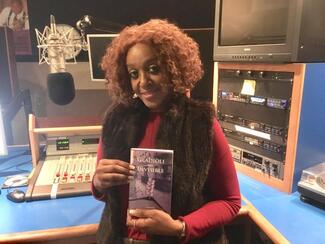Communicating With And Captivating The Community
|
book for speaking engagementsNeed an expert on your show? Book Mildred Antenor.
Mildred is a favorite chosen keynote speaker for a great many organizations and educational institutions. St. Francis, College, New Jersey City University--to name a few. She is known for her candid, clear and no nonsense style when delivering her speeches based upon her real-life experiences. www.WBGO.org. |
October is Domestic Violence Awareness month. We’re shining a light on warning signs to look out for and ways to offer a victim help.
As a nation, we’ve been grappling with the heartbreaking reality that domestic abuse is extremely prevalent in our country. Every day, it feels like there’s a new assault case in the headlines. There’s the tragic story of Gabby Petito, the travel influencer who went missing during a road trip with her fiancé Brian Laundrie. Her body was found and her death was declared a homicide by strangulation. Laundrie is a prime suspect. Then there’s the alleged news that rapper Tyga physically assaulted his girlfriend and Instagram model Genie Exum was booked for allegedly stabbing her boyfriend with a knife.
Statistics of intimate physical abuse in the U.S. paint an even darker picture. Over one in three women are victims of domestic abuse and one in five are victims of sexual abuse — with Black and minority groups being disproportionately affected. Just last year, over 4,000 indigenous women went missing in the U.S. in Canada. Most of these cases remain unsolved, but we do know that 80 percent of American Indian and Alaska Native women have experienced violence and they’re 10 times more likely to experience domestic violence than other female populations.
This is a harsh reality we cannot ignore. To learn more about ways we can help victims, we recently chatted with Mildred Antenor. She’s a professor, a women’s matters expert, and the author of The Gladioli Are Invisible: A Memoir, which recounts her experience growing up as a Haitian-American in Brooklyn, and witnessing hardships in her community — like domestic violence. At just 12-years-old, Antenor recalls a time when a family friend arrived at her mother’s apartment in a nightgown and slippers on a freezing January morning after being physically abused by a partner. “I remember her face being so disfigured. He beat her up to a pulp,” recalls Antenor. “She looked like she had spent five rounds in the boxing ring with someone.” These experiences impacted Antenor. Today, she advocates for domestic abuse awareness. “You can learn how not to do something and how to bypass a difficult situation just by noticing how it affects someone else,” she says.
The fact is: the statistics prove there’s probably someone you know who will suffer from domestic abuse. And there are certain warning signs to look out for, different types of abuse to be aware of, and ways you can help. Below, we’re breaking it down for you so you’re equipped to step in to help and educate others.
Familiarize yourself with the various types of domestic abuseDomestic violence comes in many different forms. “When we talk about domestic abuse, the first thing people think about is a punch, a slap in the face — the physical abuse,” says Antenor. But there are other types beyond the physical kind. The first step in helping a victim is understanding what those are and what they look like. Some common types of domestic abuse include:
One of the first things you can offer a victim is a safe play to stay and talk. “You can’t really force a person to see their issue, but I think it’s important to offer a listening ear,” says Antenor. If you’re in a position to offer financial help, that’s another way you can help a victim get out of a terrible situation at home.
Learn about resources that can help victimsThere are incredible resources that can help victims of domestic abuse. In an emergency situation, always call 911. If you’re looking for more information or need advice on how to create an action plan for escape, the 24/7 National Domestic Violence Hotline is an amazing (and free) resource that you confidentially can call, text, or chat. They can help you find local resources or legal help, and also have dedicated channels for deaf and Native American victims. For victims of sexual abuse, RAINN is the nation’s largest anti-sexual violence resource. They also offer a 24/7 confidential hotline, and an app that can guide you to finding the appropriate help.
If you’ve been a victim, consider sharing your storySharing how you got out of a toxic relationship can help another victim see the light. “If you’ve been a victim of domestic violence, managed to get out of it, and now you’re thriving, offer your story to that victim,” says Antenor. “If they know that you’ve been in a situation where you’ve been abused, it might help them to soften up and maybe open up to you and let you know what’s going on in their life.”
As a nation, we’ve been grappling with the heartbreaking reality that domestic abuse is extremely prevalent in our country. Every day, it feels like there’s a new assault case in the headlines. There’s the tragic story of Gabby Petito, the travel influencer who went missing during a road trip with her fiancé Brian Laundrie. Her body was found and her death was declared a homicide by strangulation. Laundrie is a prime suspect. Then there’s the alleged news that rapper Tyga physically assaulted his girlfriend and Instagram model Genie Exum was booked for allegedly stabbing her boyfriend with a knife.
Statistics of intimate physical abuse in the U.S. paint an even darker picture. Over one in three women are victims of domestic abuse and one in five are victims of sexual abuse — with Black and minority groups being disproportionately affected. Just last year, over 4,000 indigenous women went missing in the U.S. in Canada. Most of these cases remain unsolved, but we do know that 80 percent of American Indian and Alaska Native women have experienced violence and they’re 10 times more likely to experience domestic violence than other female populations.
This is a harsh reality we cannot ignore. To learn more about ways we can help victims, we recently chatted with Mildred Antenor. She’s a professor, a women’s matters expert, and the author of The Gladioli Are Invisible: A Memoir, which recounts her experience growing up as a Haitian-American in Brooklyn, and witnessing hardships in her community — like domestic violence. At just 12-years-old, Antenor recalls a time when a family friend arrived at her mother’s apartment in a nightgown and slippers on a freezing January morning after being physically abused by a partner. “I remember her face being so disfigured. He beat her up to a pulp,” recalls Antenor. “She looked like she had spent five rounds in the boxing ring with someone.” These experiences impacted Antenor. Today, she advocates for domestic abuse awareness. “You can learn how not to do something and how to bypass a difficult situation just by noticing how it affects someone else,” she says.
The fact is: the statistics prove there’s probably someone you know who will suffer from domestic abuse. And there are certain warning signs to look out for, different types of abuse to be aware of, and ways you can help. Below, we’re breaking it down for you so you’re equipped to step in to help and educate others.
Familiarize yourself with the various types of domestic abuseDomestic violence comes in many different forms. “When we talk about domestic abuse, the first thing people think about is a punch, a slap in the face — the physical abuse,” says Antenor. But there are other types beyond the physical kind. The first step in helping a victim is understanding what those are and what they look like. Some common types of domestic abuse include:
- Psychological and emotional abuse includes humiliating and degrading a victim with the intent of weakening or frightening them emotionally. It also includes verbal abuse, or regularly using words in a way that harm a person’s wellbeing.
- Financial abuse is when an abuser restricts financial resources to prevent a victim from getting out of the abusive situation. “The abuser wants you to stay in their corner so that they can continue to abuse you,” says Antenor.
- Social isolation abuse is when the abuser restricts the victim from seeing friends or family with the intention of harming their relationships. To tighten the victim’s social circle, it can also involve purposefully trying to damage their reputation online by sharing false information about them.
- Physical intimidation is another tactic in which the abuser frightens you with certain actions or gestures causing the victim to become fearful, even if no physical abuse is taking place. “Usually it takes one major fight or one blow where they actually hurt you. After that, they couple it with intimidation, like a look, yelling, or a movement they make.”
- Male privilege is also tied to certain types of domestic abuse. “The male manipulator or abuser will gaslight the female victim to believe that her male partner is superior to her,” says Antenor. “And because he is superior to her, he is entitled to do what he wants — beat her up, restrict her finances, prevent her from working, or isolate her.”
- Sexual violence is another type of abuse that can take many different forms, like rape, molestation, and drug-facilitated sexual assault. It’s one of the most common types of abuse — every 68 seconds, someone is sexually abused in the U.S.
- A sudden change in mood or behavior. If you notice someone in a relationship’s behavior really starts to change, make note of it. “It doesn’t necessarily mean they’re a victim of domestic violence, but it’s something to pay attention to, to watch how far this goes,” says Antenor.
- Extreme privacy. “Many times, the abuser will manipulate the victim to keep quiet about what’s going on in the house. If you notice that there’s this severe attention to privacy, that might mean that there is something wrong in that in that household,” says Antenor.
- Restricted interactions. Maybe you notice your friend, who usually calls you to talk for two hours, can only speak now for five minutes. Or perhaps they go out with you, but can stay for five minutes. New time limitations can sometimes be a red flag that an abuser is restricting interactions.
- Short-fused temper or filled with rage behind closed doors. Abusers will often conceal their bad temper around everyone else besides the victim.
- Excessive jealousy can often lead to possessiveness and negative emotions within a relationship. “A partner who is jealous of his partner’s accomplishments — that’s a problem,” says Antenor.
- A history of physical abuse. Slapping, punching, kicking, and abusing children and pets are extreme and serious warning signs.
- Does not allow you to be yourself or make decisions. Abusers like to control their victims. “I think a woman or man who is suffering from that should look at that closely,” says Antenor.
One of the first things you can offer a victim is a safe play to stay and talk. “You can’t really force a person to see their issue, but I think it’s important to offer a listening ear,” says Antenor. If you’re in a position to offer financial help, that’s another way you can help a victim get out of a terrible situation at home.
Learn about resources that can help victimsThere are incredible resources that can help victims of domestic abuse. In an emergency situation, always call 911. If you’re looking for more information or need advice on how to create an action plan for escape, the 24/7 National Domestic Violence Hotline is an amazing (and free) resource that you confidentially can call, text, or chat. They can help you find local resources or legal help, and also have dedicated channels for deaf and Native American victims. For victims of sexual abuse, RAINN is the nation’s largest anti-sexual violence resource. They also offer a 24/7 confidential hotline, and an app that can guide you to finding the appropriate help.
If you’ve been a victim, consider sharing your storySharing how you got out of a toxic relationship can help another victim see the light. “If you’ve been a victim of domestic violence, managed to get out of it, and now you’re thriving, offer your story to that victim,” says Antenor. “If they know that you’ve been in a situation where you’ve been abused, it might help them to soften up and maybe open up to you and let you know what’s going on in their life.”








